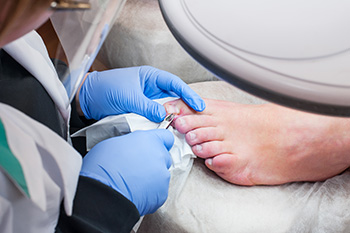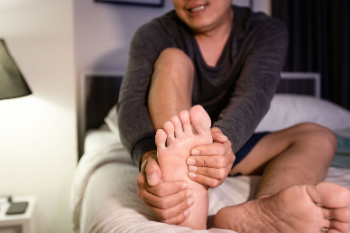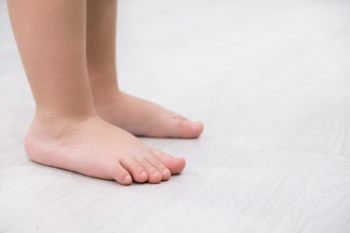Items filtered by date: June 2024
What to Expect From Ingrown Toenail Surgery

Surgery for ingrown toenails is aimed at providing relief and preventing future issues. When conservative treatments fail, a minor surgical intervention can become necessary. During the procedure, a doctor numbs the toe and removes part or all of the affected nail. This process helps to eliminate the pain and inflammation caused by the ingrown nail. After surgery, keeping the area clean and dry is essential to prevent infection. Pain and swelling are usually minimal, and pain relievers can help to manage any discomfort. Most patients can return to their normal activities within a few days, though wearing loose-fitting or open-toed shoes is recommended to avoid pressure on the toe. Proper post-surgical care, including regular follow-up visits, ensures a smooth recovery and reduces the risk of recurrence. If you have an ingrown toenail, it is suggested that you make an appointment with your podiatrist to determine if surgery is right for you.
Foot surgery is sometimes necessary to treat a foot ailment. To learn more, contact Matthew McQuaid, DPM of Lake Mendocino Podiatry. Our doctor will assist you with all of your foot and ankle needs.
When Is Surgery Necessary?
Foot and ankle surgery is generally reserved for cases in which less invasive, conservative procedures have failed to alleviate the problem. Some of the cases in which surgery may be necessary include:
- Removing foot deformities like bunions and bone spurs
- Severe arthritis that has caused bone issues
- Cosmetic reconstruction
What Types of Surgery Are There?
The type of surgery you receive will depend on the nature of the problem you have. Some of the possible surgeries include:
- Bunionectomy for painful bunions
- Surgical fusion for realignment of bones
- Neuropathy decompression surgery to treat nerve damage
Benefits of Surgery
Although surgery is usually a last resort, it can provide more complete pain relief compared to non-surgical methods and may allow you to finally resume full activity.
Surgical techniques have also become increasingly sophisticated. Techniques like endoscopic surgery allow for smaller incisions and faster recovery times.
If you have any questions please feel free to contact our offices located in Lakeport and Ukiah, CA . We offer the newest diagnostic and treatment technologies for all your foot and ankle needs.
Are You Suffering From Ingrown Toenails?
Symptoms and Causes of Plantar Fasciitis

Plantar fasciitis affects millions of people worldwide and is primarily found in active adults from 25 to 65 years old. Plantar fasciitis arises from the overstretching of the plantar fascia, a fibrous band of tissue on the sole of the foot that supports the arch. The major symptoms of inflammation and pain may develop gradually over time or suddenly after intense physical activity. The hallmark sign of plantar fasciitis is pain near the heel. This can range from a dull ache to a sharp, stabbing sensation, often most severe upon waking in the morning or after prolonged rest. Additional indicators include tenderness to touch, stiffness, and increased discomfort after extended periods of activity. Factors that contribute to its onset include repetitive stress from activities like running, dancing, or prolonged standing. Other possible causes are excess weight, improper footwear, and biomechanical issues, such as high or low foot arches. If you are experiencing persistent heel pain that may be linked to plantar fasciitis, it is suggested that you make an appointment with a podiatrist for an exam and diagnosis, followed by treatment options.
Plantar fasciitis can be very painful and inconvenient. If you are experiencing heel pain or symptoms of plantar fasciitis, contact Matthew McQuaid, DPM from Lake Mendocino Podiatry. Our doctor can provide the care you need to keep you pain-free and on your feet.
What Is Plantar Fasciitis?
Plantar fasciitis is the inflammation of the thick band of tissue that runs along the bottom of your foot, known as the plantar fascia, and causes mild to severe heel pain.
What Causes Plantar Fasciitis?
- Excessive running
- Non-supportive shoes
- Overpronation
- Repeated stretching and tearing of the plantar fascia
How Can It Be Treated?
- Conservative measures – anti-inflammatories, ice packs, stretching exercises, physical therapy, orthotic devices
- Shockwave therapy – sound waves are sent to the affected area to facilitate healing and are usually used for chronic cases of plantar fasciitis
- Surgery – usually only used as a last resort when all else fails. The plantar fascia can be surgically detached from the heel
While very treatable, plantar fasciitis is definitely not something that should be ignored. Especially in severe cases, speaking to your doctor right away is highly recommended to avoid complications and severe heel pain. Your podiatrist can work with you to provide the appropriate treatment options tailored to your condition.
If you have any questions please feel free to contact our offices located in Lakeport and Ukiah, CA . We offer the newest diagnostic and treatment technologies for all your foot and ankle needs.
Diabetes and Wound Healing

Diabetic wound care is a critical aspect of managing diabetes-related complications, particularly concerning foot health. Diabetes can affect wound healing due to vascular and neuropathic issues that result from high blood sugar levels. Reduced circulation and oxygenation in tissues, coupled with neuropathy-induced numbness, make foot wounds more susceptible to infections. Individuals experiencing poor wound healing due to diabetes-related nerve and blood vessel damage may encounter additional complications, including heart disease, kidney disease, and eye problems. Additionally, if an untreated wound becomes infected, the infection may extend locally to affect muscle and bone, a condition known as osteomyelitis. Untreated infections also can progress to gangrene, a significant cause of amputations in individuals with diabetes. In severe cases, uncontrolled infections can lead to sepsis, wherein the infection spreads into the bloodstream, posing a life-threatening situation. A podiatrist is trained to manage diabetic wounds in the feet. If you are living with diabetes or have concerns about wound care, it is suggested that you schedule an appointment with a podiatrist for a full exam and treatment options.
Wound care is an important part in dealing with diabetes. If you have diabetes and a foot wound or would like more information about wound care for diabetics, consult with Matthew McQuaid, DPM from Lake Mendocino Podiatry. Our doctor will assess your condition and provide you with quality foot and ankle treatment.
What Is Wound Care?
Wound care is the practice of taking proper care of a wound. This can range from the smallest to the largest of wounds. While everyone can benefit from proper wound care, it is much more important for diabetics. Diabetics often suffer from poor blood circulation which causes wounds to heal much slower than they would in a non-diabetic.
What Is the Importance of Wound Care?
While it may not seem apparent with small ulcers on the foot, for diabetics, any size ulcer can become infected. Diabetics often also suffer from neuropathy, or nerve loss. This means they might not even feel when they have an ulcer on their foot. If the wound becomes severely infected, amputation may be necessary. Therefore, it is of the upmost importance to properly care for any and all foot wounds.
How to Care for Wounds
The best way to care for foot wounds is to prevent them. For diabetics, this means daily inspections of the feet for any signs of abnormalities or ulcers. It is also recommended to see a podiatrist several times a year for a foot inspection. If you do have an ulcer, run the wound under water to clear dirt from the wound; then apply antibiotic ointment to the wound and cover with a bandage. Bandages should be changed daily and keeping pressure off the wound is smart. It is advised to see a podiatrist, who can keep an eye on it.
If you have any questions, please feel free to contact our offices located in Lakeport and Ukiah, CA . We offer the newest diagnostic and treatment technologies for all your foot care needs.
Causes and Managing of Flat Feet in Children

Flat feet, medically termed pes planus, is a common condition among children, indicated by a lack of arch in the foot. While many children naturally outgrow flat feet as they develop, some may experience persistent symptoms that warrant attention. The causes of flat feet in children vary, including genetics, lax ligaments, muscle weakness, or developmental abnormalities. Additionally, factors like obesity, improper footwear, or excessive standing can worsen the condition. Identifying flat feet in children involves observing certain signs, such as foot pain, fatigue, or an uneven gait. Although flat feet often do not cause significant issues, severe cases may lead to discomfort and difficulty walking. They may even contribute to other lower limb problems later in life. Management strategies typically focus on alleviating symptoms through supportive footwear, orthotic inserts, or stretching exercises. If your child does not gradually develop arches in their feet, it is suggested that a podiatrist be consulted who can conduct an exam and monitor flat feet.
The health of a child’s feet is vital to their overall well-being. If you have any questions regarding foot health, contact Matthew McQuaid, DPM of Lake Mendocino Podiatry. Our doctor can provide the care you need to keep you pain-free and on your feet.
Tips for Keeping Children's Feet Healthy
- Make sure their shoes fit properly
- Look for any signs of in-toeing or out-toeing
- Check to see if they have Clubfoot (condition that affects your child’s foot and ankle, twisting the heel and toes inward) which is one of the most common nonmajor birth defects.
- Lightly cover your baby’s feet (Tight covers may keep your baby from moving their feet freely, and could prevent normal development)
- Allow your toddler to go shoeless (Shoes can be restricting for a young child’s foot)
- Cut toenails straight across to avoid ingrown toenails
- Keep your child’s foot clean and dry
- Cover cuts and scrapes. Wash any scratches with soap and water and cover them with a bandage until they’ve healed.
If you have any questions, please feel free to contact our offices located in Lakeport and Ukiah, CA . We offer the newest diagnostic and treatment technologies for all your foot care needs.

